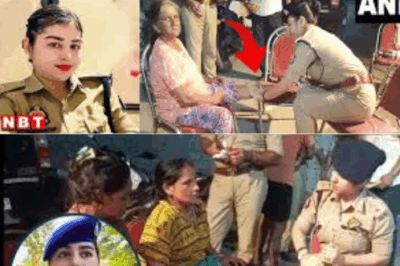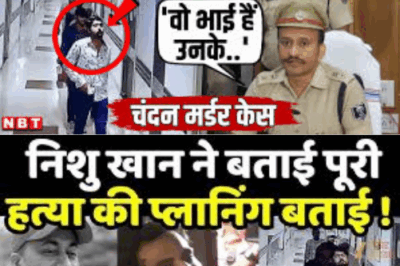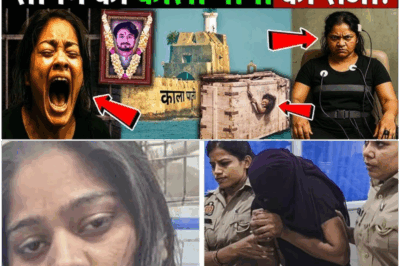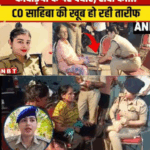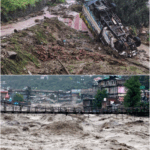A fight breaks out over the narrator’s caste in an Indian village, sparking heated debate.
.
.
.
Caste Controversy Erupts in Indian Village After Storyteller’s Identity Is Questioned
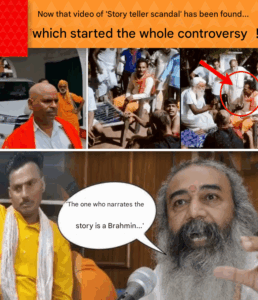
A recent viral video from rural India has reignited a fiery national debate over caste identity, religious authority, and social hierarchy. The footage, which shows villagers confronting the popular storyteller Mukut Mani Maharaj and demanding proof of his caste, has exposed the persistence of caste-based discrimination and the deep fissures that still run through Indian society, especially in its villages.
The Incident: A Storyteller Under Scrutiny
The controversy began in a small, unnamed village where Mukut Mani Maharaj, a well-known religious storyteller, was performing a traditional katha—a form of spiritual storytelling revered in Hindu culture. Maharaj, who claims to have been narrating stories for over 14 years, was suddenly surrounded by a group of villagers, including both elders and youths.
In the tense video, which has since gone viral on social media, the villagers can be seen and heard aggressively questioning Maharaj about his caste. Some accused him of hiding his true identity, suggesting that he was pretending to be a Brahmin—a caste historically associated with priestly duties and religious authority—when in fact, they claimed, he was a Yadav or even from a caste considered lower than Yadav.
The villagers demanded that Maharaj prove his caste status, asking to see his father’s caste certificate and even his Aadhaar card, the government-issued identity document. The confrontation quickly escalated, with some villagers accusing Maharaj of misleading the community for personal gain and others insisting that only Brahmins should be permitted to perform religious storytelling or have Brahmins touch their feet.
“I Have No Caste”: Maharaj’s Response
Throughout the heated exchange, Mukut Mani Maharaj remained calm but firm. He repeatedly stated, “I have no caste. I have been telling stories for 14-15 years.” Maharaj explained that his work as a storyteller was based on his knowledge and devotion, not his caste identity.
He also clarified that he never used the surname ‘Agnihotri’—a common Brahmin surname—and always introduced himself simply as Mukut Mani Maharaj. Despite this clarification, the villagers remained unconvinced, pressing him for further proof and accusing him of deceit.
One elder was seen pointing a finger at Maharaj and declaring, “You have become a saint by lying!” Another demanded, “Show us your documents! We want to see your father’s caste!” The crowd’s anger was palpable, and the confrontation grew increasingly hostile.
The Heart of the Dispute: Caste and Ritual Authority
At the core of the controversy is not Maharaj’s storytelling ability or his knowledge of religious texts, but rather his caste status and the traditional belief that only Brahmins are entitled to perform certain rituals and receive reverence from others, including having their feet touched by other Brahmins.
The villagers’ outrage centered on the claim that Maharaj, allegedly a Yadav or lower-caste individual, had allowed Brahmins to touch his feet—a gesture traditionally reserved for those of higher or equal caste. For many in the crowd, this was seen as a violation of the established social order and an affront to their customs.
The incident highlights the enduring power of caste in rural India, where centuries-old hierarchies continue to dictate social interactions and religious practices. Despite decades of legal reforms aimed at eradicating caste discrimination, such attitudes remain deeply ingrained in many communities.
Allegations and Accusations
As the confrontation continued, the accusations against Maharaj intensified. Some villagers accused him of deliberately hiding his caste to gain respect and financial support from the community. Others alleged that he was misleading people by adopting the appearance and mannerisms of a Brahmin, thereby usurping a role that was not rightfully his.
One villager was heard saying, “You are deceiving people for money. If you are not a Brahmin, you should not be performing these rituals.” Another added, “We trusted you because we thought you were one of us. Now you have betrayed our faith.”
The demands for official documents—such as caste certificates and Aadhaar cards—reflect a growing trend of using bureaucratic proof to enforce social boundaries, even in religious and cultural contexts.
Public Reaction: A Divided Community
After the video was posted online, it quickly gained traction and sparked a heated debate both within the village and across the wider Indian public. Some viewers sided with the villagers, arguing that Maharaj had a responsibility to be transparent about his identity, especially given the sensitive nature of religious storytelling.
Others, however, condemned the villagers’ actions as blatant caste discrimination. Many pointed out that the real issue was not Maharaj’s caste, but the persistence of prejudices that have no place in a modern, democratic society.
Social media platforms were flooded with comments, some expressing outrage at the humiliation Maharaj was subjected to, while others defended the villagers’ right to protect their traditions. Hashtags such as #CasteDiscrimination and #JusticeForMaharaj began trending, reflecting the polarized nature of the debate.
Echoes of Kabir: “Do Not Ask a Person’s Caste”
The incident has also revived interest in the teachings of Kabir, the 15th-century poet and saint who famously wrote, “Do not ask a person’s caste.” Kabir’s message, which challenged the rigid social hierarchies of his time, remains as relevant today as it was centuries ago.
Many commentators have cited Kabir’s couplet in response to the video, urging viewers to look beyond caste and judge individuals by their character and actions. “India has made progress, but incidents like this show how far we still have to go,” wrote one social media user. “We need to remember Kabir’s words and treat everyone with respect.”
The Broader Context: Caste in Contemporary India
While India’s Constitution abolishes “untouchability” and guarantees equality before the law, caste continues to shape social, economic, and political life, especially in rural areas. The persistence of caste-based discrimination is evident in incidents like the one involving Mukut Mani Maharaj, where questions of ritual purity and social status can still provoke intense emotions and conflict.
Sociologists point out that religious roles, such as storytellers, priests, and ritual performers, are often closely linked to caste. In many villages, only members of certain castes are allowed to perform specific religious functions, and violations of these norms can lead to social ostracism or worse.
Despite efforts by reformers and activists to challenge these norms, resistance remains strong, particularly among older generations who see caste as an essential part of their identity and community structure.
Legal and Social Reforms: Progress and Challenges
In recent decades, the Indian government has implemented a range of policies aimed at promoting social equality and reducing caste-based discrimination. Reservations in education and employment, legal protections, and public awareness campaigns have all contributed to significant progress.
However, as the incident with Maharaj demonstrates, legal reforms alone are not enough to change deeply held beliefs and practices. Social change is often slow and uneven, with progress in urban areas sometimes offset by continued resistance in rural communities.
Activists argue that education and dialogue are essential to overcoming caste prejudice. “We need to teach our children that everyone is equal, regardless of their caste,” said one local teacher. “Only then can we hope to build a truly inclusive society.”
The Aftermath: Reflection and Unanswered Questions
As the dust settles, the village remains divided. Some residents continue to defend their actions, insisting that they were only protecting their traditions. Others have expressed regret over the way Maharaj was treated, acknowledging that the incident has brought unwanted attention and shame to their community.
For Maharaj, the experience has been deeply painful. In a statement released after the video went viral, he said, “I have always tried to bring people together through my stories. I never imagined that my caste would become more important than my words.”
The video ends with a narrator urging viewers to reflect on who is truly at fault: the villagers who subjected Maharaj to public humiliation, or Maharaj himself for allegedly hiding his identity. The answer, many argue, lies not in blaming individuals but in confronting the broader social attitudes that make such incidents possible.
Conclusion: A Call for Introspection
The confrontation in this Indian village is more than just a local dispute—it is a microcosm of the larger struggle over caste, identity, and equality in India today. While the country has made remarkable strides toward social justice, incidents like this serve as a sobering reminder of how much work remains to be done.
As the debate continues to rage online and offline, one thing is clear: the path to a more just and inclusive society will require not only legal reforms but also a fundamental shift in attitudes and values. Only by embracing the spirit of equality championed by thinkers like Kabir can India hope to overcome the divisions that still hold it back.
play video:
News
Kanwar Yatra Viral News: CO Rishika Singh massaged the feet of Kanwariyas | Muzaffarnagar CO Viral
Kanwar Yatra Viral News: CO Rishika Singh massaged the feet of Kanwariyas | Muzaffarnagar CO Viral As the sacred month…
Chandan Mishra Murder Case: What did Patna SSP say about accused Tauseef and his brother Nishu Khan?
Chandan Mishra Murder Case: What did Patna SSP say about accused Tauseef and his brother Nishu Khan? In the early…
Chandan Mishra Murder Case: What did main accused Tauseef Badshah’s brother Nishu Khan say?
Chandan Mishra Murder Case: What did main accused Tauseef Badshah’s brother Nishu Khan say? Patna – Kolkata | July 2025In…
Did Raja Raghuvanshi get justice? Sonam will be sentenced to black water! Sonam – Raja Raghuvanshi Case!
Did Raja Raghuvanshi get justice? Sonam will be sentenced to black water! Sonam – Raja Raghuvanshi Case! . . ….
Urfi Javed Painful Lip Filler Leaves Face Severely Swollen and Unrecognisable
Urfi Javed Painful Lip Filler Leaves Face Severely Swollen and Unrecognisable . . . Urfi Javed’s Painful Lip Filler Procedure…
The lead actress of TV became poor overnight, does not have money even to eat, forced to work as a maid
The lead actress of TV became poor overnight, does not have money even to eat, forced to work as a…
End of content
No more pages to load

